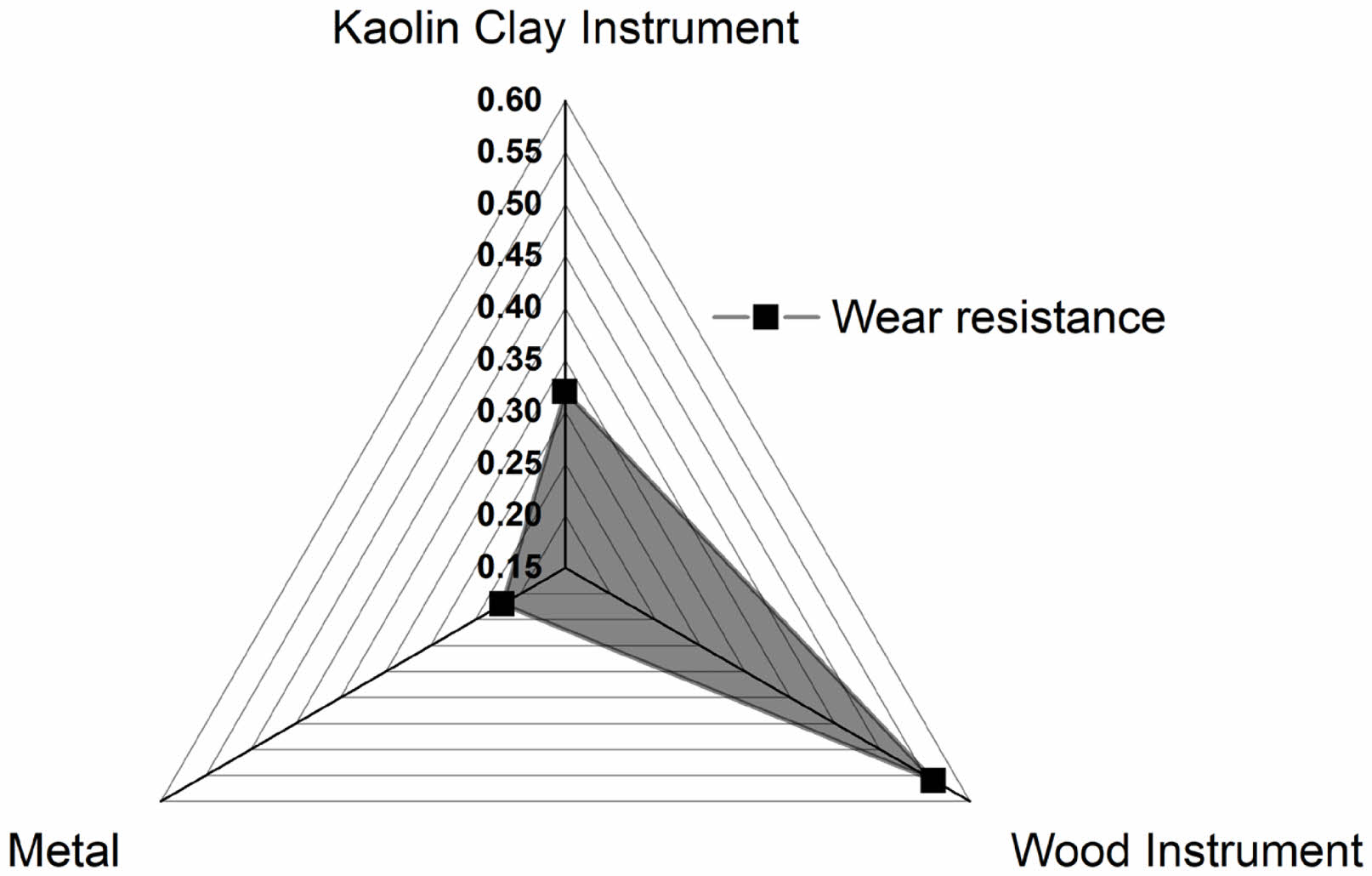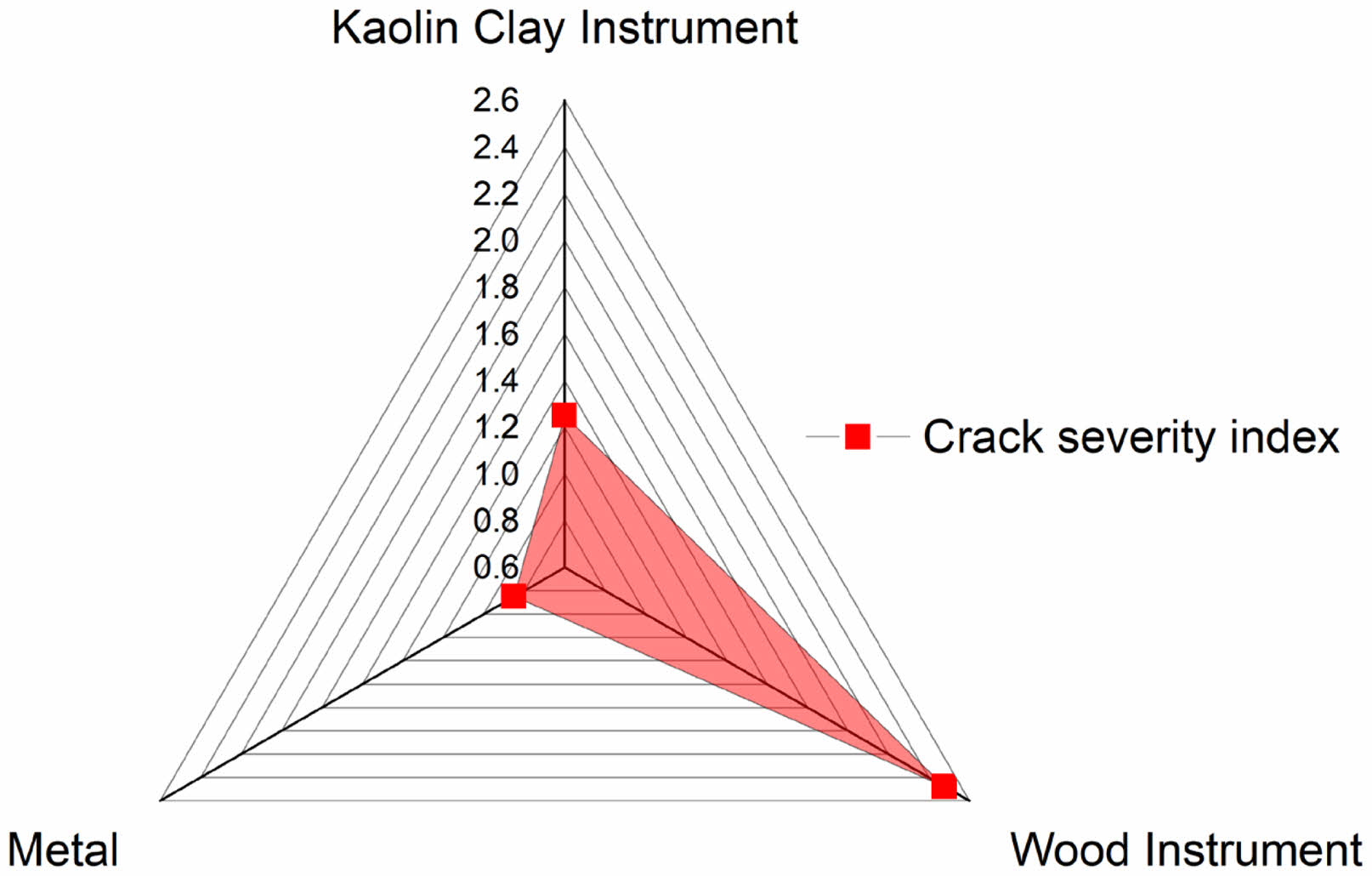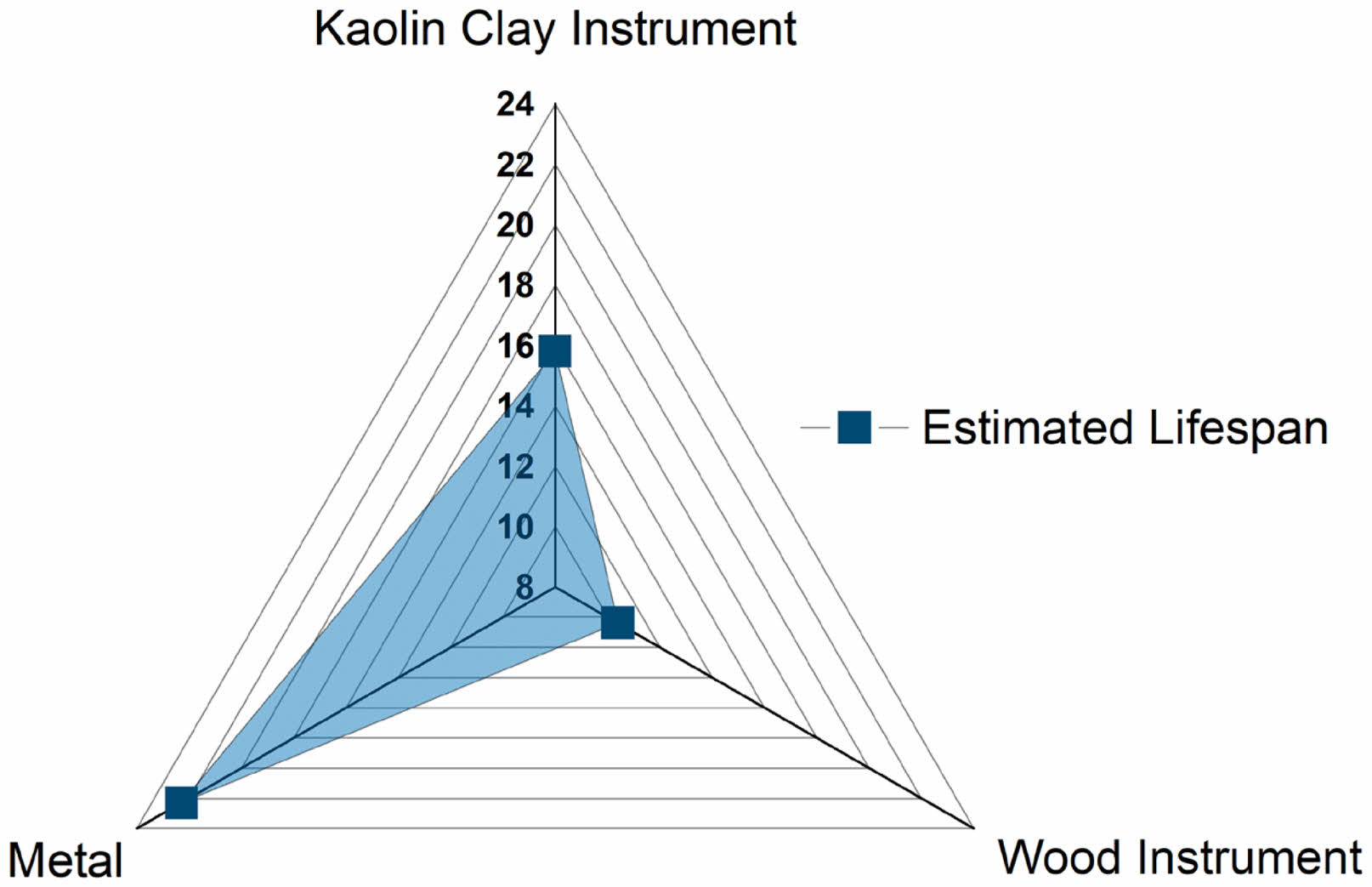- Comparative analysis of kaolin clay, wood, and metal in musical instrument durability, environmental resilience, and longevity
Jiawei Zhaoa,*, Yan Zhua and Mingwei Lib
aXinyang College, Xinyang, 464000, China
bXinyang Normal University, Xinyang, 464000, ChinaThis article is an open access article distributed under the terms of the Creative Commons Attribution Non-Commercial License (http://creativecommons.org/licenses/by-nc/4.0) which permits unrestricted non-commercial use, distribution, and reproduction in any medium, provided the original work is properly cited.
This work explores the potential of kaolin clay as a material for the fabrication of musical instruments, particularly in the context of percussion and wind instruments. Kaolin, a fine and pure form of clay, is known for its excellent plasticity, thermal stability, and ability to be molded into intricate shapes. These properties make kaolin a promising candidate for creating instruments with unique acoustic characteristics. The study investigates how the density, microstructure, and firing process of kaolin clay affect the sound quality, resonance, and tonal clarity of the instruments. The research highlights that kaolin’s fine grain structure and smooth surface finish can contribute to a distinct, resonant sound that is both warm and clear. Additionally, the durability and resistance to environmental factors provided by kaolin could result in instruments with a longer lifespan and reduced maintenance needs. The findings suggest that kaolin clay can not only replicate the tonal qualities of traditional materials but also introduce new timbres, expanding the expressive possibilities for musicians. This study advances the understanding of kaolin clay’s role in musical instrument manufacturing, offering insights into the creation of innovative and sustainable instruments.
Keywords: Kaolin clay, Environmental Resilience, Longevity.
In recent years, there has been a growing interest in the development of sustainable materials for musical instruments, driven by the need to avoid the use of animal-derived resources and to explore new frontiers in musical expression [1]. Historically, many traditional instruments were crafted from materials obtained from endangered species, such as tortoiseshell, ivory, and exotic woods [2]. The continued use of these materials raises ethical concerns and threatens biodiversity. Reproducing these instruments using synthetic alternatives not only protects endangered species but also offers a means to better understand the cultural and historical significance of music in ancient societies [3]. By creating replicas that mimic the acoustic and physical properties of their natural counterparts, we can preserve the heritage of these instruments while promoting conservation efforts.
Ceramic materials, which include both traditional ceramics derived from clay and advanced ceramics with specialized properties, present a promising solution in the search for alternative materials [4]. Traditional ceramics have a long history of use in musical instruments, particularly in folklore, where instruments such as ocarinas and jaltarangs are crafted from clay. These instruments demonstrate the enduring connection between ceramics and music, and their unique tonal qualities have been cherished across cultures for centuries [5]. However, the potential of advanced ceramics, which offer enhanced mechanical and acoustic properties, remains largely unexplored in the field of musical instrument manufacturing. Advanced ceramics are already employed in sound-related applications, such as sound absorbers and sensors, but their application in creating musical instruments is a relatively new frontier [6].
A novel category of advanced ceramics known as bioinspired ceramics has gained significant attention [7-9]. These materials are distinguished by their ability to mimic the structural characteristics of natural substances, such as bones and seashells, which imbue them with properties that set them apart from conventional ceramics. One of the key advantages of bioinspired ceramics is their reduced brittleness compared to traditional ceramics, making them more durable and practical for various applications [10].
The innovative nature of bioinspired ceramics, rooted in principles of bioinspiration and biomimicry, has garnered positive reception from both the general public and key stakeholders. This positive perception is largely due to the ability of ceramics to replicate the complex microstructures found in nature, leading to enhanced mechanical properties and functionality [11, 12]. Despite being composed of synthetic materials, bioinspired ceramics offer a unique combination of strength and resilience, demonstrating the potential for these materials to revolutionize industries that rely on advanced ceramics. This blend of artificial creation and natural design principles positions bioinspired ceramics as a promising frontier in materials science.
This research seeks to investigate the potential of both traditional and advanced ceramics (kaolin clay) as sustainable and ethically responsible alternatives to animal-derived materials in the fabrication of musical instruments. By exploring the acoustic properties, durability, and aesthetic possibilities of ceramic materials, this study aims to contribute to the development of innovative instruments that respect environmental and ethical concerns while expanding the expressive capabilities of musicians. In doing so, this research not only addresses pressing conservation issues but also opens new avenues for creativity and cultural preservation in the world of music.
The kaolin samples utilized in this study were sourced from Maoming Special Material Ltd. A total of 4000 g from each location was soaked in 7.5 liters of water for 24 hours to create a slurry and dissolve impurities and other unwanted materials. After the soaking period, the surface water was carefully decanted, and the slurry was sieved using a 350 µm mesh sieve. The sieved material was then dried, pulverized, and further sieved to ensure that only particles with sizes ≤ 100 µm passed through. The metakaolinization process involved heating the samples to temperatures between 600 °C and 900 °C for 2 hours in a muffle furnace.
In Fig. 1 it can be seen that the metal instrument exhibits the lowest wear rate at 0.22 mm/year. This superior wear resistance can be attributed to the high hardness and tensile strength of metals, which are typically more resistant to abrasion and deformation. The crystalline structure of metals, along with their ability to form a protective oxide layer, reduces surface degradation over time. Metals like brass, commonly used in instruments, possess excellent mechanical properties that contribute to their durability under repeated stress and exposure to elements. The kaolin clay instrument shows a moderate wear rate of 0.32 mm/year. Kaolin clay is a ceramic material with good hardness and resistance to scratching, but it is more brittle compared to metals. The wear resistance of kaolin clay is likely enhanced by its fine-grained structure, which allows for a smooth surface finish that can resist surface abrasion to some extent. However, its brittleness may lead to micro-cracking under mechanical stress, which can contribute to a moderate rate of wear. The wood instrument displays the highest wear rate at 0.56 mm/year. Wood is an organic material with a cellular structure, which, while providing flexibility and a desirable acoustic quality, is more susceptible to mechanical wear. The wear rate in wood is influenced by factors such as the density and hardness of the wood species used, as well as its moisture content. Wood’s porous structure can absorb moisture, leading to swelling and increased friction during use, which accelerates wear. Additionally, wood is prone to degradation from environmental factors such as humidity and temperature fluctuations, which further contribute to its higher wear rate.
The environmental impact on the materials (kaolin clay, wood, and metal) was evaluated by exposing the instruments to various environmental conditions such as humidity, temperature fluctuations, and UV exposure (Fig. 2). The behavior of these materials under such conditions highlights their susceptibility to degradation, reflected by the crack severity index. The metal instrument demonstrated the lowest crack severity index of 0.85, indicating superior resistance to environmental factors. Metals, particularly those used in instrument manufacturing such as brass or steel, possess a dense, non-porous structure that minimizes the absorption of moisture and reduces the effects of temperature variations. Furthermore, metals often form a passive oxide layer that protects the underlying material from corrosion and surface deterioration. This layer acts as a barrier against environmental elements, making metal instruments particularly resilient in a wide range of conditions, including high humidity and UV exposure. The kaolin clay instrument showed a moderate crack severity index of 1.25. Kaolin clay, being a ceramic material, has a stable crystalline structure that provides good resistance to environmental stresses. Its low porosity helps prevent moisture absorption, and its inherent chemical inertness makes it less susceptible to degradation from UV radiation or chemical exposure. However, kaolin clay is brittle and can develop micro-cracks when subjected to extreme temperature changes or mechanical stresses. These micro-cracks can propagate under continuous environmental strain, leading to moderate structural impact over time. The wood instrument exhibited the highest crack severity index of 2.48, indicating significant susceptibility to environmental conditions. Wood is an organic material with a fibrous, porous structure that readily absorbs moisture, leading to swelling, warping, and cracking when exposed to fluctuating humidity levels. The hygroscopic nature of wood, combined with its tendency to shrink or expand with temperature changes, makes it particularly vulnerable to environmental degradation. Additionally, prolonged exposure to UV light can cause photodegradation, leading to discoloration, surface cracking, and a reduction in structural integrity. These factors contribute to the high environmental impact observed in wood instruments, necessitating more frequent maintenance and environmental control.
The lifespan estimation of instruments made from kaolin clay, wood, and metal was determined through accelerated aging tests (Fig. 3). These tests simulate long-term usage and environmental exposure, providing an estimate of the expected durability and longevity of each material under typical conditions.
The metal instrument is estimated to have the longest lifespan of 22.3 years. This extended lifespan is primarily due to the material’s superior mechanical properties and resistance to wear, corrosion, and environmental degradation. Metals such as brass and stainless steel, commonly used in musical instruments, are known for their robustness and structural integrity. The natural formation of a protective oxide layer on the surface of metals further enhances their durability, preventing significant degradation over time. Additionally, metals maintain their physical and acoustic properties with minimal change, contributing to their longevity and making them a preferred choice for instruments that require long-term reliability. The kaolin clay instrument has an estimated lifespan of 15.8 years, reflecting its moderate durability. Kaolin clay’s ceramic nature provides good resistance to wear and environmental factors, but its brittleness can lead to the development of micro-cracks and eventual material failure over extended periods. While kaolin clay is less prone to the rapid degradation seen in organic materials like wood, its vulnerability to mechanical stress and thermal shock can limit its lifespan compared to metal. However, with proper handling and care, kaolin clay instruments can still offer a reasonably long service life, particularly in environments where they are protected from extreme mechanical or environmental stresses. The wood instrument is estimated to have the shortest lifespan of 10.4 years. This reduced lifespan is a result of wood’s susceptibility to wear, environmental impact, and biological degradation. Wood’s hygroscopic nature causes it to absorb and release moisture, leading to cycles of swelling and shrinking that weaken its structure over time. Additionally, wood is vulnerable to decay, insect damage, and photodegradation, especially in environments with fluctuating humidity and temperature. These factors contribute to the gradual loss of structural integrity and acoustic quality, necessitating more frequent repairs or replacements. Despite these limitations, wood remains highly valued for its unique tonal qualities, though its shorter lifespan requires consideration of maintenance and environmental control to maximize its durability.

|
Fig. 1 Wear resistance study on kaolin clay, metal and wood instruments. |

|
Fig. 2 Crack severity study on kaolin clay, metal and wood instruments. |

|
Fig. 3 Life span estimation of kaolin clay, metal and wood instruments. |
The wear resistance behavior of these materials is a reflection of their mechanical and structural properties. Metal, with its robust structure and protective surface characteristics, offers the best wear resistance, making it ideal for long-lasting instruments. Kaolin clay, while not as resistant as metal, provides a good balance of durability and tonal qualities, making it a viable alternative for specific applications. Wood, despite its higher wear rate, remains favored in certain contexts for its unique acoustic properties, though it requires more frequent maintenance and care to counteract its susceptibility to wear. The environmental impact behavior of these materials underscores the importance of material choice based on the intended use and exposure conditions of the instruments. Metal instruments offer exceptional durability with minimal environmental impact, making them ideal for use in varied and harsh conditions. Kaolin clay, while more susceptible to environmental stress than metal, still provides a good balance of stability and resilience, making it a strong candidate for applications where environmental factors are a concern. Wood, while highly valued for its acoustic qualities, is the most affected by environmental conditions, requiring careful management and protective measures to maintain its structural integrity over time. The lifespan estimation of these materials highlights the trade-offs between durability and acoustic properties in the selection of materials for musical instruments. Metal instruments, with their exceptional durability, offer the longest lifespan, making them ideal for applications where longevity and minimal maintenance are crucial. Kaolin clay provides a balance between durability and acoustic performance, offering a moderately long lifespan suitable for a range of environments. Wood, while offering superior tonal qualities, has the shortest lifespan due to its susceptibility to environmental and biological degradation, requiring careful maintenance to preserve its integrity over time. The choice of material should thus be guided by the specific needs of the instrument and its intended use environment.
- 1. T. Duerinck, G. Verberkmoes, C. Fritz, M. Leman, L. Nijs, M. Kersemans, and W.V. Paepegem, J. Acoust. Soc. Am. 147 (2020) 2647-2655.
-

- 2. M.M. Jalili, S.Y. Mousavi, and A.S. Pirayeshfar, Polym. Compos. 35[11] (2014) 2103-2111.
-

- 3. T. Ono and D. Isomura, Acoust. Sci. Technol. 25[6] (2004) 475-477.
-

- 4. Teruaki Ono, Isoko Takahashi, and Yasuo Takasu, Acoust. Sci. Technol. 30[6] (2009) 410.
-

- 5. A. Damodaran, L. Lessard, and A.S. Babu, Acoust Aust 43[1] (2015) 117-122
-

- 6. C. Rujinirun, P. Phinyocheep, W. Prachyabrued, and N. Laemsak, Wood Sci. Technol. 39 (2005) 77.
-

- 7. S. Phillips and L. Lessard, J. Compos. Mater. 46[2] (2012) 145-154.
-

- 8. U.G.K. Wegst. Annu. Rev. Mater. Res. 38[1] (2008) 323.
-

- 9. P. Trtik, J. Dual, D. Keunecke, D. Mannes, P. Niemz, P Stahli, A. Kaestner, A. Groso, and M. Stampanoni, J. Struct. Biol. 159[1] (2007) 46-55.
-

- 10. F. Bouville, J. Mater. Res. 35 (2020) 1076-1094.
-

- 11. R. Kohsaka, Y. Fujihira, Y. Uchiyama, S. Kajima, S. Nomura, and F. Ebinger, Curator Museum J 60[4] (2017) 427-444.
-

- 12. G.M. Whitesides, Interface Focus 5[4] (2015) 20150031.
-

 This Article
This Article
-
2024; 25(5): 918-921
Published on Oct 31, 2024
- 10.36410/jcpr.2024.25.5.918
- Received on Aug 2, 2024
- Revised on Sep 23, 2024
- Accepted on Sep 27, 2024
 Services
Services
Shared
 Correspondence to
Correspondence to
- Jiawei Zhao
-
Xinyang College, Xinyang, 464000, China
Tel : +8615660952700 - E-mail: 576634219@qq.com






 Copyright 2019 International Orgranization for Ceramic Processing. All rights reserved.
Copyright 2019 International Orgranization for Ceramic Processing. All rights reserved.